Mario Matassa takes a look at International Women’s Day. He revels in the mystery of the celebrations and presents some of the classic dishes…
Photos by Mario Matassa
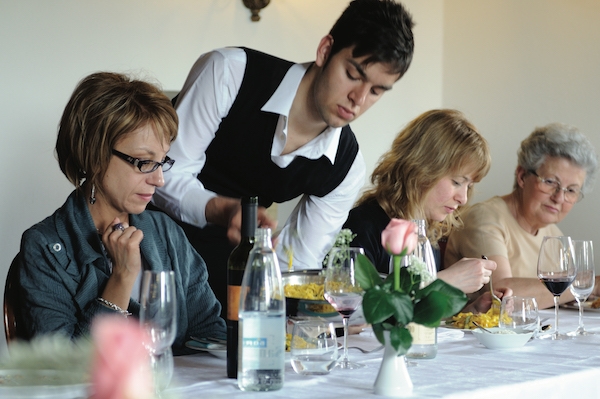
The 8th of March is the day when women across Italy hang up their aprons, put on their best frocks, and walk out of the door – leaving us poor men behind to fend for ourselves. For many Italian men that genuinely still means having to settle for a panino or two in the bar. For me it’s not so much of a problem as I consider myself a fairly deft hand in the kitchen, but for a lot of my friends I know it’s a day they dread. They can’t even resort to their mother’s house for dinner because even mamma takes the day off on March the 8th.
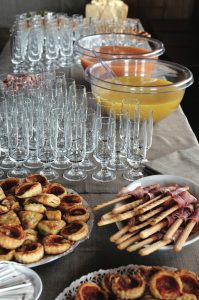 International Women’s Day is of course a global celebration of the economic, political and social achievements of women past, present and future. It has its roots in early 20th-century socialist movements in Eastern Europe, with the first IWD being observed in Germany in 1911. It didn’t become popular in the West, however, until the 1970s. In Italy, the Festa della Donna was first held in 1946, organised by the feminist UDI (Union of Italian Women) and its popularity today is such that it’s become something of a de facto unofficial public holiday – for women. And, unlike many festivals, it’s one of those rare events that is celebrated throughout the country. So, if you are a woman in Italy on the 8th of March, wherever you are, there’s going to be a party happening somewhere nearby. The only downside, if you consider it such, is that you’ll have to leave your husband or boyfriend in the hotel or the local bar.
International Women’s Day is of course a global celebration of the economic, political and social achievements of women past, present and future. It has its roots in early 20th-century socialist movements in Eastern Europe, with the first IWD being observed in Germany in 1911. It didn’t become popular in the West, however, until the 1970s. In Italy, the Festa della Donna was first held in 1946, organised by the feminist UDI (Union of Italian Women) and its popularity today is such that it’s become something of a de facto unofficial public holiday – for women. And, unlike many festivals, it’s one of those rare events that is celebrated throughout the country. So, if you are a woman in Italy on the 8th of March, wherever you are, there’s going to be a party happening somewhere nearby. The only downside, if you consider it such, is that you’ll have to leave your husband or boyfriend in the hotel or the local bar.
For men, the day does have its perks. Though we are left to fend for ourselves, we can take some consolation in the fact that we don’t have to remember to buy flowers. The yellow mimosa is the flower of choice, and women exchange bouquets among themselves. The story has it that the yellow mimosa was chosen as a symbol by the women of Rome because it was sweet-smelling, one of the few flowers available in March and – perhaps most importantly – did not cost very much. The tradition took hold and the yellow mimosa has since become an Italian symbol of Women’s Day. And this is also reflected in the recipes used to celebrate the day.
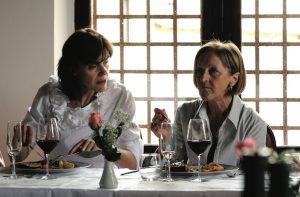 The other tradition that comes with the day is eating out. Go anywhere in Italy on the 8th of March and the restaurants will be filled with women. You’ll be hard pushed to see a man anywhere, unless he’s carrying a plate or a bottle of wine. The tables are filled with friends, sisters, aunts, cousins, daughters, mothers, grandmothers and even great grandmothers.
The other tradition that comes with the day is eating out. Go anywhere in Italy on the 8th of March and the restaurants will be filled with women. You’ll be hard pushed to see a man anywhere, unless he’s carrying a plate or a bottle of wine. The tables are filled with friends, sisters, aunts, cousins, daughters, mothers, grandmothers and even great grandmothers.
With the exception of the torta mimosa (which has taken on something of the air of a national dish), there is no traditional Women’s Day menu. Regionality, as in all things culinary in Italy, plays its usual part. The only common factor is the colour yellow. Most of the dishes prepared are presented in shades of yellow. Hence eggs are a common ingredient, as is saffron, which is used to colour a risotto (as in the classic risotto milanese) or the creamy sauce of a stew. Fresh golden yellow pasta, often made with a little saffron-infused water to enhance the colour, is also a regular on the menu. Seafood dishes with lemon sauces are popular along the coastline, while polenta features strongly in the mountainous regions.
What goes on?
As for what actually happens during the Women’s Day celebrations, I’m afraid I can’t say with any certainty. For reasons unknown to me, women tend to be very secretive – almost conspiratorial – about the Women’s Day dinner and they don’t tend to tell us men very much about it. Of course, I can (and will) speculate. And so will all the other men in the bar. There’s little else left for us to do. Rumours abound. In fact, there’s a discussion in the bar on the subject of the Women’s Day dinner every year, albeit not a particularly informed one, as no one who has ever actually attended a Women’s Day dinner is there.
The only thing that can be said with any certainty is that the noise levels coming from the restaurant are such that one would be forgiven for thinking there was a rugby team reunion taking place rather than a simple dinner. Meanwhile, the men in the bar hold on to the consolation that it’s only one day of the year and that tomorrow we’ll all be eating proper food again.
 La Zucca
La Zucca
Una zucca is usually a pumpkin or a marrow but the word can be used to apply to anything in the squash family – which is why zucchini (‘little zuccas’) are courgettes…
Le zucche (plural) are very popular in the north, and the very best are considered to be those grown in and around Mantua – pumpkin risotto is a very popular dish in restaurants in the area, the creamy flesh of the zucca blends well with rice. Marrows are roasted and fried, as well as being an habitual ingredient in minestrone. Bought fresh and whole from local markets (with a good length of stalk on them) a good pumpkin will keep in the cellar for most of the winter.
Click here for Mario’s zuppa di zucca e gamberi (butternut squash soup with prawns) recipe
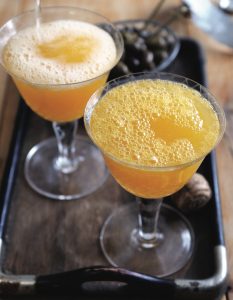 Prosecco and fruit juice
Prosecco and fruit juice
Italians generally tend to drink cocktails before dinner – never with, and seldom after. As with all good Italian cocktails, these are not particularly alcoholic and are intended merely to whet the appetite.
This is a variation on the classic Mimosa cocktail, which is originally champagne and orange juice in equal measures. (A Buck’s Fizz is two parts bubbly to one part orange juice.) Being Italian, we are of course using prosecco instead of champagne, and we are reversing the proportions, so it’s one part prosecco to two parts fruit juice.
Mario shares his recipe for a ‘Women’s Day cocktail’ here
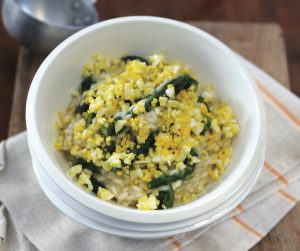 Risotto mimosa
Risotto mimosa
It is uncertain when this dish was first made, but it has become something of a staple for the Festa della Donna. The chopped egg gives the dish its distinctive colour and often the rice itself will also be infused with saffron.
Although the Festa della Donna does not have any religious connotations itself, eggs are commonly used on festive occasions in Italy, especially in the spring – they symbolise fertility and the beginning of life. The use of asparagus in this dish is hardly coincidental. Eggs and asparagus is a classic combination and, together with arborio rice, creates a perfect match.
Fancy making risotto mimosa (asparagus and egg risotto)? Here it is!
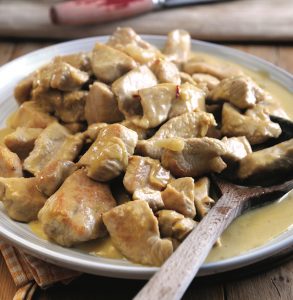 Saffron
Saffron
Saffron (zafferano) is one of the most expensive spices you can buy, so it is fortunate that a little goes a long way and that you don’t have to be a millionaire to enjoy it. The main reason is it so expensive is that the three stigmas in each saffron flower have to be harvested by hand, a time-consuming job that has to be done at just the right moment because the stigmas are very easily blown away by the wind. It takes a staggering 65,000 to 75,000 flowers to yield a pound of saffron, so production of this delicate spice uses a lot of land too. This also helps to explain the price. However, just a hint of saffron is enough to tinge a risotto or a cream sauce a beautifully delicate yellow. The aroma is intense, and the flavour is sweet, often mild, but highly distinctive.
Click here for Mario’s tacchino con zafferano e panna (turkey with saffron and cream) recipe
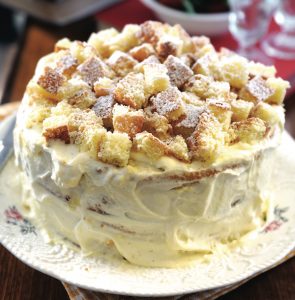 Mimosa cake
Mimosa cake
The mimosa cake is a cake covered with pieces of sponge cake, reminiscent of the flowers of the mimosa. Almost certainly, it was first made around the same time as the mimosa was chosen to be a symbol of Women’s Day. Being a poisonous flower, mimosa cannot be used as an ingredient and therefore the sponge is chopped up to give the appearance of mimosa. While regional preferences still dictate menus across the country for the Festa della Donna, the mimosa cake is the one exception and is served on tables from north to south.
Make delicious mimosa cake here
For more of Mario’s series exploring Italian food, click here
